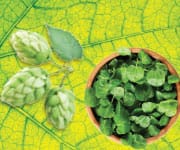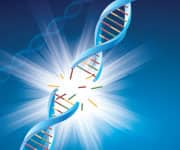Life Extension Magazine®
On a daily basis, our DNA is under attack from numerous sources, including radiation, oxidative stress, environmental hazards, and dietary carcinogens.
The extent to which DNA damage occurs—or can be prevented—correlates closely with how long we will live.1
One course of action is to protect ourselves with compounds that can prevent DNA damage before it leads to cancer.
Based on extensive research, scientists have discovered a natural hops-derived flavonoid compound, xanthohumol, that has been shown in clinical (human) studies to reduce DNA damage in cells2-4—which may reduce the risk of cancer.
Two additional compounds—chlorophyllin and watercress extract—have been recognized for their multitargeted capacity to reduce DNA damage.
The combination of these targeted compounds may offer the best possible natural protection against age-accelerating, cancer-inducing damage to our DNA.
This is especially important for those who occasionally or routinely ingest overcooked foods and other dietary constituents that inflict considerable harm to our cellular DNA.
What you need to know
- A critically important way to prevent aging and stave off cancer is to prevent DNA damage.
- New studies show that xanthohumol, a component of hops, prevents DNA damage and acts by multiple mechanisms to reduce the risk of cancer.
- Xanthohumol can protect DNA against both natural chemical stresses as well as those induced by dietary carcinogens, making it a lead compound in the fight against cancer.
- Chlorophyllin and watercress extract are also recognized for their multitargeted capacity to reduce DNA damage.
- Supplementation with nutrients that protect against DNA damage is an outstanding first step in helping to prevent cancer.
DNA Damage and Cancer

Genetic mutations that occur as a result of DNA damage increase the risk of developing cancer.5-7
Cancer is the second leading cause of death in Americans.8 Abundant citations in the scientific literature focus on DNA damage and its prevention as a way to protect against malignancies.
Scientists are excited about research on the DNA protective benefits of a flavonoid present in hops, xanthohumol.
Research data show that xanthohumol has a cancer-prevention profile and acts by a variety of mechanisms to prevent cancer initiation. The compound’s ability to prevent DNA damage has scientists most intrigued.2-4,9-12
Two recent human studies highlight the impact of xanthohumol on reducing DNA damage.
Impressive Protection Against DNA Damage
In a randomized, placebo-controlled clinical trial, 22 healthy individuals drank a malted beverage containing 12 mg of xanthohumol or a placebo for 14 days.10
Subjects had their blood and urine collected before, during, and after the supplementation period.10
The researchers were specifically looking for changes in DNA stability in white blood cells, as well as the urinary excretion of damaged fragments of DNA and of reactive oxygen species.
This phase of the study showed that subjects drinking the xanthohumol beverage experienced a remarkable reduction in DNA damage compared with those drinking the placebo.10
By the end of the 14-day study, the effect reached a reduction of 33% in DNA damage.
DNA Protection Under Pressure
Next, the researchers wanted to find out how well xanthohumol would equip cells with resistance to DNA breaks under conditions of chemical stress. To test this, they exposed subjects’ cells to hydrogen peroxide, a potent generator of the reactive oxygen species that impose DNA-damaging chemical stress.
Xanthohumol did not disappoint.
Once again, cells from xanthohumol-supplemented subjects proved markedly resistant to chemically-induced DNA damage compared with those from placebo recipients. This time a significant effect was evident by Day 7, and climbed to a maximum 53% reduction in DNA damage at the end of the study period.
In order to be certain that it was the xanthohumol that was responsible for this protection and not some other component of the test beverage, the researchers carried out a second phase of the study using a capsule of purified xanthohumol at the same 12-mg dose.10
This second phase demonstrated similar results: The pure xanthohumol produced a 39% reduction in DNA damage, and a 28% improvement in the resistance to DNA damage induced by hydrogen peroxide.10
Protection Against Dietary Carcinogens
The same group of scientists then carried out a follow-up study, pushing xanthohumol’s protective effects even harder. This time, they evaluated how well the supplement works against the everyday challenge of dietary carcinogens.
To test this, 22 participants consumed a drink containing 12 mg of xanthohumol. The researchers then stressed the subjects’ DNA by exposing blood cells to representatives of three major classes of DNA-damaging dietary carcinogens:2
- N-Nitrosodimethylamine (NDMA)
- Benzopyrene
- -amino-3-methylimidazo[4,5-f]quinolone (IQ) (a type of heterocyclic amine)
The xanthohumol led to reductions in DNA damage caused by NDMA, benzopyrene, and the heterocyclic amine.
And when the researchers conducted a follow-up trial using xanthohumol capsules (instead of the drink), it once again showed similar reductions in DNA damage in the face of each compound.2
This study is of great importance because it elucidates some of the molecular mechanisms by which xanthohumol may protect human cells from the first step in carcinogenesis: the DNA damage that mutates the genetic code and provides the spark needed to trigger malignant transformation.
Xanthohumol Prevents Precancerous Lesions
Animal studies have gone the next step in demonstrating the chemoprotective effects of xanthohumol. They have shown that in addition to preventing DNA damage, xanthohumol also prevents the development of precancerous lesions.
To prove this effect, researchers exposed xanthohumol-supplemented healthy rats to a common family of dietary carcinogens (called heterocyclic amines) that forms when meat is cooked at high temperatures.4,13 Heterocyclic amines have been linked to breast, prostate, colorectal, gastric, and pancreatic cancers.14-18
In this study, the xanthohumol-supplemented animals experienced a significant 50% reduction in the number of precancerous sites in their livers, and a 44% decrease in the size of the lesions, demonstrating a robust effect.4 Not surprisingly, the researchers found evidence that the supplement achieved these results by preventing DNA damage in liver cells.
These human and animal studies show that xanthohumol protects DNA from damage both directly from chemical stress and indirectly from dietary carcinogens.
Broadening the Spectrum of DNA Protection
Humans aren’t alone in our need for DNA protection. All living things are challenged in protecting against DNA damage, including plants and animals.
Plants face even greater risks than animals do in this regard because they can’t seek shade, water, or nourishment when DNA-threatening environmental stress sets in. This means that plants are naturally rich in biochemical DNA-protective compounds. That’s good news for humans, because these plant compounds seem to work as well in our cells as they do in theirs.
Several plant species and extracts are especially known for their ability to defend DNA against the chemical, radiation, and other stresses that threaten its integrity.
Chlorophyllin
Chlorophyllin is a water-soluble derivative of chlorophyll,19 a pigment that makes plants green and captures light and channels it safely into energy within plant cells.
Studies show that chlorophyllin exerts powerful protection against DNA damage.19-22 Like most natural compounds, chlorophyllin acts by multiple mechanisms, one of which is by blocking carcinogens and making them less bioavailable.19,20
This benefit was vividly seen in two studies showing chlorophyllin’s ability to protect against the damage caused by two known DNA-damaging carcinogens: aflatoxins and heterocyclic amines.
The first study examined people who had an elevated risk of liver cancer because of their consumption of aflatoxin-contaminated foods. In this study, taking chlorophyllin led to a 55% reduction in median urinary levels of a marker of aflatoxin-induced DNA damage.20
The second study evaluated chlorophyllin’s ability to protect against the damage caused by heterocyclic amines. The results showed that chlorophyllin significantly reduced DNA damage in colorectal cells following a meal of meat cooked at high temperatures, a dangerous source of cancer-causing heterocyclic amines.22
Watercress

Watercress is a cruciferous vegetable, a group of plants widely recognized for their multitargeted anticancer activities.23 Watercress extracts are rich in antioxidants capable of fighting the oxidative stress that damages DNA.24
In human studies, supplementation with watercress significantly reduced DNA damage by up to 24% in healthy volunteers. This benefit was seen both at rest and following vigorous exercise, which is known to briefly but powerfully induce DNA damage by oxidative stress.23,24
This indicates the potential of watercress to protect DNA in stressful situations that could otherwise lead to dangerous DNA damage.
Summary

DNA damage is ubiquitous and deadly. While it is best known for its role in cancer development, it is also implicated in a wide range of aging processes.
Xanthohumol, a compound found in hops, has now been shown in human and animal studies to significantly reduce DNA damage induced both by natural chemical stresses, as well as by some notorious dietary carcinogens.
In addition, chlorophyllin and watercress have been shown to reduce DNA damage via several mechanisms.
Fortunately, science has identified powerful nutrients that protect against DNA damage and its consequences.
If you have any questions on the scientific content of this article, please call a Life Extension® Wellness Specialist at 1-866-864-3027.
References
- Debrabant B, Soerensen M, Flachsbart F, et al. Human longevity and variation in DNA damage response and repair: study of the contribution of sub-processes using competitive gene-set analysis. Eur J Hum Genet. 2014;22(9):1131-6.
- Pichler C, Ferk F, Al-Serori H, et al. Xanthohumol Prevents DNA Damage by Dietary Carcinogens: Results of a Human Intervention Trial. Cancer Prev Res (Phila). 2017;10(2):153-60.
- Carvalho DO, Oliveira R, Johansson B, et al. Dose-Dependent Protective and Inductive Effectsof Xanthohumol on Oxidative DNA Damage inSaccharomyces cerevisiae. Food Technol Biotechnol. 2016;54(1):60-9.
- Ferk F, Huber WW, Filipic M, et al. Xanthohumol, a prenylated flavonoid contained in beer, prevents the induction of preneoplastic lesions and DNA damage in liver and colon induced by the heterocyclic aromatic amine amino-3-methyl-imidazo[4,5-f]quinoline (IQ). Mutat Res. 2010;691(1-2):17-22.
- Lee SC, Chan JC. Evidence for DNA damage as a biological link between diabetes and cancer. Chin Med J (Engl). 2015;128(11):1543-8.
- Li L, Zhu T, Gao YF, et al. Targeting DNA Damage Response in the Radio(Chemo)therapy of Non-Small Cell Lung Cancer. Int J Mol Sci. 2016;17(6).
- Roos WP, Thomas AD, Kaina B. DNA damage and the balance between survival and death in cancer biology. Nat Rev Cancer. 2016;16(1):20-33.
- Available at: https://www.cdc.gov/nchs/fastats/leading-causes-of-death.htm. Accessed 13 Feb, 2017.
- Dietz BM, Kang YH, Liu G, et al. Xanthohumol isolated from Humulus lupulus Inhibits menadione-induced DNA damage through induction of quinone reductase. Chem Res Toxicol. 2005;18(8):1296-305.
- Ferk F, Misik M, Nersesyan A, et al. Impact of xanthohumol (a prenylated flavonoid from hops) on DNA stability and other health-related biochemical parameters: Results of human intervention trials. Mol Nutr Food Res. 2016;60(4):773-86.
- Plazar J, Filipic M, Groothuis GM. Antigenotoxic effect of Xanthohumol in rat liver slices. Toxicol In Vitro. 2008;22(2):318-27.
- Plazar J, Zegura B, Lah TT, et al. Protective effects of xanthohumol against the genotoxicity of benzo(a)pyrene (BaP), 2-amino-3-methylimidazo[4,5-f]quinoline (IQ) and tert-butyl hydroperoxide (t-BOOH) in HepG2 human hepatoma cells. Mutat Res. 2007;632(1-2):1-8.
- Puangsombat K, Gadgil P, Houser TA, et al. Occurrence of heterocyclic amines in cooked meat products. Meat Sci. 2012;90(3):739-46.
- Zheng W, Lee SA. Well-done meat intake, heterocyclic amine exposure, and cancer risk. Nutr Cancer. 2009;61(4):437-46.
- Koutros S, Berndt SI, Sinha R, et al. Xenobiotic metabolizing gene variants, dietary heterocyclic amine intake, and risk of prostate cancer. Cancer Res. 2009;69(5):1877-84.
- Cross AJ, Freedman ND, Ren J, et al. Meat consumption and risk of esophageal and gastric cancer in a large prospective study. Am J Gastroenterol. 2011;106(3):432-42.
- Sinha R, Chow WH, Kulldorff M, et al. Well-done, grilled red meat increases the risk of colorectal adenomas. Cancer Res. 1999;59(17):4320-4.
- Anderson KE, Mongin SJ, Sinha R, et al. Pancreatic cancer risk: associations with meat-derived carcinogen intake in the Prostate, Lung, Colorectal, and Ovarian Cancer Screening Trial (PLCO) cohort. Mol Carcinog. 2012;51(1):128-37.
- Egner PA, Munoz A, Kensler TW. Chemoprevention with chlorophyllin in individuals exposed to dietary aflatoxin. Mutat Res. 2003;523-524:209-16.
- Egner PA, Wang JB, Zhu YR, et al. Chlorophyllin intervention reduces aflatoxin-DNA adducts in individuals at high risk for liver cancer. Proc Natl Acad Sci U S A. 2001;98(25):14601-6.
- Gao F, Hu XF. Analysis of the therapeutic effect of sodium copper chlorophyllin tablet in treating 60 cases of leukopenia. Chin J Integr Med. 2005;11(4):279-82.
- Shaughnessy DT, Gangarosa LM, Schliebe B, et al. Inhibition of fried meat-induced colorectal DNA damage and altered systemic genotoxicity in humans by crucifera, chlorophyllin, and yogurt. PLoS One. 2011;6(4):e18707.
- Gill CI, Haldar S, Boyd LA, et al. Watercress supplementation in diet reduces lymphocyte DNA damage and alters blood antioxidant status in healthy adults. Am J Clin Nutr. 2007;85(2):504-10.
- Fogarty MC, Hughes CM, Burke G, et al. Acute and chronic watercress supplementation attenuates exercise-induced peripheral mononuclear cell DNA damage and lipid peroxidation. Br J Nutr. 2013;109(2):293-301.

